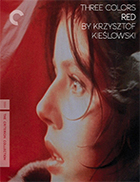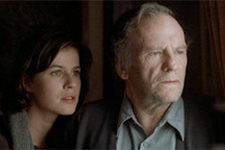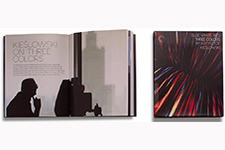| Director: Krzysztof Kieślowski | | Screenplay: Krzysztof Piesiewicz and Krzysztof Kieślowski | | Stars: Irène Jacob (Valentine), Jean-Louis Trintignant (The Judge), Frédérique Feder (Karin), Jean-Pierre Lorit (Auguste), Samuel Le Bihan (Photographer), Marion Stalens (Veterinarian), Teco Celio (Barman), Bernard Escalon (Record dealer), Jean Schlegel (Neighbor, )Elzbieta Jasinska (Woman), Paul Vermeulen (Karin’s friend), Jean-Marie Daunas (Theatre manager), Roland Carey (Drug dealer) | | MPAA Rating: R | | Year of Release: 1994 | | Country: France / Poland / Switzerland |  |
|  Red (Rouge), the last film in Krzysztof Kieślowski’s trilogy based around the three ideals of the French national motto—liberté, égalité, fraternité (liberty, equality, fraternity)—also turned out to be the final film of the great filmmaker’s career. He announced his retirement from filmmaking at the film’s premiere at the Cannes Film Festival, perhaps because he had a premonition that his life was drawing to a close (he died two years later at the age of 54). Red turned out to be a fitting conclusion to Kieślowski’s career, a summative capstone of not just the Three Colors (Trois couleurs) trilogy, but also of the director’s recurring themes of doubling, interconnectedness, and finding order in what otherwise seems like a universe of random occurrences. Thus, it is only fitting that we begin discussing Red at the end of the film, which features a simultaneous tragedy and miracle that features the seven main characters of all three films in the trilogy. From one perspective, this is an act of extreme narrative contrivance, arguably bringing the film (and the trilogy) to an end on a note of absolute absurdity. Yet, one can only see this ending as contrived if one’s view is limited to the inherently narrow focus of the films themselves and sees the final moments of Red as Kieślowski and co-writer Krzysztof Piesiewicz (who worked on all three films) bringing the characters together. But, what if we work backward, starting with the seven characters at the end of Red and think of them as an otherwise random assortment of human beings whose lives happen to intersect in this one tragic moment, and each of the films is Kieślowski and Piesiewicz’s exploration of their lives before they intersected? From that perspective, the ending of Red is not a contrivance, but rather one of an infinitesimal number of human interactions that take place and have taken place every second of every minute of every day of human history. That is where Kieślowski’s ambitions lie. The nominal ideal behind Red is “fraternity,” which suggests the coming together of people who have something in common. For Kieślowski, our commonality is our humanity, which is why all the films in the trilogy feature characters who are at some point alienated and alone before finding connection with others. In Red, we first meet Valentine (Irène Jacob, who also starred in Kieślowski’s The Double Life of Veronique), a fashion model living and studying in Geneva. She has a boyfriend with whom she is only able to communicate via telephone, usually in terse conversations that betray his incessant jealousy. Valentine’s life intersects with that of Joseph Kern (Jean-Louis Trintignant), a reclusive retired judge who spends his time spying on his neighbors via their cordless telephones, when she accidentally hits his dog with her car. Valentine and Kern would seem to have nothing in common, yet they are drawn together into a strangely affecting friendship that changes both of them immensely and for the better. Meanwhile, Valentine’s relationship with both her never-seen boyfriend and Kern is reflected in various ways in the story of Auguste (Jean-Pierre Lorit), a young legal student who lives across the street from her and is in the beginning stage of a romantic relationship with a woman named Karin (Frédérique Feder). All four of these characters—Valentine, Kern, Auguste, and Karin—live in intersecting orbits that none of them ever fully realize. Valentine and Auguste, although often sharing the frame together, are each unaware of the other’s existence. Karin, meanwhile, is one of Kern’s neighbors and is unaware that he is listening to her telephone conversations with Auguste. Kern is different, in that he has knowledge that the others don’t, not only because of his voyeurism, but also because he seems to be possessed of some kind of second sight or premonition. This is revealed in moments both banal (he comments on the beauty of the light mere seconds before the sun comes out from behind a cloud) and mystical (he dreams about Valentine’s future and also sees in Auguste and Karin a reliving of his own past). Although he is first introduced as the very epitome of the “creepy old man,” Kern is eventually revealed to be a man of great sadness who is lifted out of his own self-imposed prison by nothing grander than Valentine’s simple empathy. She feels for him even as she is disgusted by his behavior, and he is moved by her humanity and begins to reclaim his own. Red is thus a beautiful film both emotionally and philosophically, not to mention aesthetically. Cinematographer Piotr Sobocinski (who was nominated for an Oscar and, like Kieślowski, died far too young) emboldens the film’s themes about interconnection and shared humanity with fluid tracking shots that tie the various characters together in time and space while also suggesting a soothing kind of omnipotence that provides a compelling sense of order. The color of the title is infused throughout the film in ways both enormous (the giant billboard that features Valentine’s image, the theater in which a fashion show takes place) and small (the yogurt Valentine eats at the beginning of the film, a ferry ticket). We are, of course, invited to read into the color’s significance in multiple, sometimes contradictory ways, which is only appropriate given that red is both the most emotionally intense color on the spectrum and also the one with the most varied of symbolic meanings. Whatever we read into the color itself, it is inescapable that Kieślowski’s use of it signals above all the intensity of feeling that is completely unique to the human condition, which is, in and of itself, the perfect final statement of his impressive cinematic career. | Three Colors: Red Criterion Collection 4K UHD |  Three Colors: White is available exclusively as part of the six-disc “Blue White Red: Three Colors by Krzysztof Kieślowski” box set, which also includes Three Colors: Blue (1993) and Three Colors: White (1994) on both 4K UHD and Blu-ray. Three Colors: White is available exclusively as part of the six-disc “Blue White Red: Three Colors by Krzysztof Kieślowski” box set, which also includes Three Colors: Blue (1993) and Three Colors: White (1994) on both 4K UHD and Blu-ray. | | Aspect Ratio | 1.85:1 (all three films) | | Audio | French DTS-HD Master Audio 5.1 surround (all three films) | | Subtitles | English | | Supplements | Three Colors: Blue“Cinema Lesson With Director Krzysztof Kieślowski” featurette“On Blue” video essay by film studies professor Annette InsdorfVideo interview with Three Colors composer Zbigniew PreisnerSelected-scene commentary by actor Juliette Binoche“Reflections on Blue” featurette“Kieślowski: The Early Years” featuretteThe Tram (1966), a student short by KieślowskiThe Face (1966), a short starring KieślowskiOriginal theatrical trailer Three Colors: White “Cinema Lesson With Director Krzysztof Kieślowski” featurette“On White” video essay by film critic Tony RaynsVideo interview with cowriter Krzysztof PiesiewiczVideo interviews with actors Zbigniew Zamachowski and Julie DelpyShort documentary on the making of WhiteTwo short documentaries by Kieślowski: Seven Women of Different Ages (1978) and Talking Heads (1980) Original theatrical trailerThree Colors: Red “Cinema lesson with director Krzysztof Kieślowski” featurette “On Red” video essay by film writer Dennis LimVideo interview with actor Irène JacobVideo interview with producer Marin KarmitzVideo interview with editor Jacques WittaBehind-the-scenes footageShort documentary on the film’s world premiere at CannesKrzysztof Kieślowski: I’m So-So ... (1995) feature-length documentaryOriginal theatrical trailerInsert booklet featuring essays by film critics Colin MacCabe, Nick James, Stuart Klawans, and Georgina Evans; an excerpt from Kieślowski on Kieślowski; and reprinted interviews with cinematographers Sławomir Idziak, Edward Klosinski, and Piotr Sobocinski | | Distributor | The Criterion Collection | | Release Date | February 7, 2023 | | | COMMENTS | | Criterion originally released the three films in the Three Colors trilogy on Blu-ray in November 2011, and they looked great for that time. This new 4K UHD + Blu-ray box set includes all new restorations of the three films, starting with new 4K scans of each film’s original 35mm camera negative by MK2 and subsequent digital restoration. The restoration of Blue was performed under the supervision of cinematographer Sławomir Idziak,while the restoration of Red was supervised by cinematographers Piotr Sobociński Jr. and Michał Sobociński, the sons of the late cinematographer Piotr Sobociński. The restoration of White was done with reference to an archival 35mm theatrical print as a color reference. All three films in the Three Colors trilogy looks absolutely gorgeous, with substantial improvement over the previously available Blu-rays, especially when viewed using Dolby Vision HDR, which gives the films’ intense color schemes even more vibrant life. Criterion has delivered a trio of top-notch transfers that have Kieślowski’s final films looking better than they ever have, at least since their theatrical releases. All three films boast great contrast and detail, good depth, a fine veneer of grain to give them a pleasantly filmlike appearance, and absolutely gorgeous colors that are even more naturalistic and less manipulated than earlier releases. The blues, whites, and reds that dominate the respective films are appropriately cool, clean, and sensual. I can’t imagine the films looking much better on video. This box set also offers a big improvement in sound, with each film boasting a newly mixed DTS-HD 5.1-channel surround soundtrack created from the 35mm magnetic tracks (the Blu-rays feature two-channel surround tracks). Sound is a crucial element of Kieślowski’s films, whether it be the orchestral scores or the diegetic sounds that often provide as much, if not more, narrative and thematic information than the visuals. The soundtracks are clean and well defined and have an impressive robustness and sense of depth and immersion. All of the supplements from the 2011 Blu-ray box are included here. As befits a box set dedicated to the thematically and narratively interlocking films of the Three Colors trilogy, there are a series of repeating rhymes and patterns in the supplements for each of the three films. In lieu of an audio commentary, each film is given a 20-minute visual essay created in 2011 in which an esteemed film scholar examines its themes and aesthetics: Blue is covered by film studies professor Annette Insdorf, White is covered by critic and festival programmer Tony Rayns, while Red is covered by film critic Dennis Lim. Each of the three films also contains a “Cinema Lesson With Director Krzysztof Kieślowski,” which are short video pieces that apparently ran on French television around 1994. In each piece Kieślowski sits at an editing table and discusses in detail how he conceived and shot a particular scene from the respective film (the sugar cube sequence in Blue, the opening credits sequence in White, and Rita running away from Valentine in Red). Each disc also features each film’s original theatrical trailer, as well as video interviews (running an average of 19 to 20 minutes in length) with Kieślowski’s collaborators recorded in 2011 that shed light on both the production of each film and what it was like to work with the masterful director. On Blue we get an interview with composer Zbigniew Preisner, who has collaborated with Kieślowski on numerous projects since the mid-1980s, including The Decalogue and all three Colors films. The White disc contains an interview with co-writer Krzysztof Piesiewicz (who co-wrote all three films) and interviews with actors Zbigniew Zamachowski and Julie Delpy. And the Red disc features interviews with actor Irène Jacob, producer Marin Karmitz (who produced all three films), and editor Jacques Witta (who also edited Blue). Criterion also dug into the archives, giving us an impressive array of older material to help contextualize the films and shed some light on the entirety of Kieślowski’s career. The Blue disc features two student films from 1966, The Tram, which Kieślowski directed, and The Face, in which he starred, as well as several supplements from 2004 that, from what I gather, had not been available in Region 1 prior to Criterion’s 2011 box set. These include a selected-scene commentary by Juliette Binoche and two featurettes: “Reflections on Blue,” which runs about 18 minutes, and “Kieślowski: The Early Years,” which runs about 15 minutes. Both featurettes include interviews with actor Juliette Binoche, film scholar Annette Insdorf, film critic Geoff Andrew, filmmaker Agnieszka Holland, cinematographer Sławomir Idziak, actor Irène Jacob, and editor Jacques Witta. On the White disc we have two of Kieślowski’s short documentaries, Seven Women of Different Ages (1978) and Talking Heads (1980), as well as a brief making-of featurette from 1994 that features behind-the-scenes footage during the production of White. And, on the Red disc we also have a short behind-the-scenes featurette from 1994, a short documentary about the film’s world premiere at the Cannes Film Festival, and Krzysztof Kieślowski: I’m So-So ... (1995), a 55-minute documentary that is essentially a lengthy interview with Kieślowski at his home in Poland. It originally aired on Danish television and was completed less than a year before the director’s death. And, finally, the handsomely designed box set also includes a thick insert booklet that features essays by film critics Colin MacCabe, Nick James, Stuart Klawans, and Georgina Evans; an excerpt from Kieślowski on Kieślowski; and reprinted interviews with cinematographers Sławomir Idziak, Edward Klosinski, and Piotr Sobocinski. |
Copyright © 2023 James Kendrick Thoughts? E-mail James Kendrick All images copyright © The Criterion Collection |




 (4)
(4)

 Three Colors: White is available exclusively as part of the six-disc “Blue White Red: Three Colors by Krzysztof Kieślowski” box set, which also includes Three Colors: Blue (1993) and Three Colors: White (1994) on both 4K UHD and Blu-ray.
Three Colors: White is available exclusively as part of the six-disc “Blue White Red: Three Colors by Krzysztof Kieślowski” box set, which also includes Three Colors: Blue (1993) and Three Colors: White (1994) on both 4K UHD and Blu-ray.